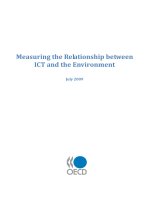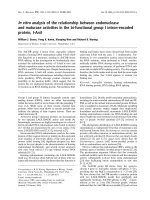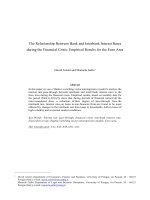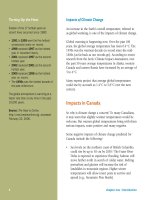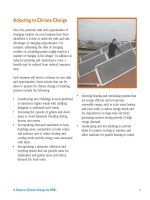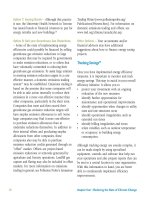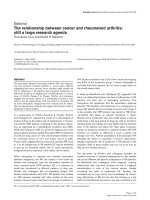The relationship between small and medium sized enterprises’ characteristics and their innovative capacity evidences from firms in quang ninh province
Bạn đang xem bản rút gọn của tài liệu. Xem và tải ngay bản đầy đủ của tài liệu tại đây (639.66 KB, 50 trang )
VIETNAM NATIONAL UNIVERSITY, HANOI
VIETNAM JAPAN UNIVERISTY
HOANG VAN TRUNG
THE RELATIONSHIP BETWEEN SMALL
AND MEDIUM-SIZED ENTERPRISES’
CHARACTERISTICS AND THEIR
INNOVATIVE CAPACITY: EVIDENCES
FROM FIRMS IN QUANG NINH
PROVINCE
MASTER’S THESIS
VIETNAM NATIONAL UNIVERSITY, HANOI
VIETNAM JAPAN UNIVERISTY
HOANG VAN TRUNG
THE RELATIONSHIP BETWEEN SMALL
AND MEDIUM-SIZED ENTERPRISES’
CHARACTERISTICS AND THEIR
INNOVATIVE CAPACITY: EVIDENCES
FROM FIRMS IN QUANG NINH
PROVINCE
MAJOR: PUBLIC POLICY
CODE: 8340402.01
RESEARCH SUPERVISOR:
Dr. VU HOANG LINH
Hanoi, 2021
PLEDGE
This Master thesis represents my own work in accordance with Vietnam National
University regulations. All sources, both cited and paraphrased, are properly
acknowledged throughout the thesis. All translations are mine or taken from a source is
clearly identified in the main text and the references.
Student signature
Student name
July, 2021
ACKNOWLEDGMENT
I would like to express my sincere gratitude to my supervisor Dr. Vu Hoang Linh.
He has been accompanying me in each stage of the thesis, from discussing the right
approach to commenting on the final draft. I also want to thank Vietanalytics and
MASSEI, where I am currently affiliated with, for allowing me to access the DDCI
Quang Ninh 2019 data for the purpose of academic research. I really appreciated those
informal discussions that I had with the directors of the companies. Those discussions
have cumulated in the topic of this thesis. I owe a big thank to the Thesis Defense
Committee Members, especially Dr. Nguyen Thuy Anh, Dr. Dang Quang Vinh, and the
Referees, for giving me lots of constructive comments and questions. Finally, I am
thankful to the tremendous encouragements from my family, friends, and colleagues.
They have been the reasons why I can work so persistently in completing the thesis.
TABLE OF CONTENTS
LIST OF TABLES .......................................................................................................... i
LIST OF FIGURES ........................................................................................................ ii
LIST OF ABBREVIATION.......................................................................................... iii
CHAPTER 1 : INTRODUCTION...................................................................................1
1.1. Context ..................................................................................................................1
1.2. Objectives .............................................................................................................3
CHAPTER 2 : LITERATURE REVIEW........................................................................6
2.1. Innovation .............................................................................................................6
2.2. Innovation Value Chain ........................................................................................6
CHAPTER 3 : METHODOLOGY ................................................................................11
3.1. Dependent variables ............................................................................................11
3.1.1. Composite variables .....................................................................................11
3.1.2. A continuous variable ..................................................................................15
3.2. Explanatory variables for SMEs’ innovation value chain in Quang Ninh .........15
3.2.1. Binary variables ...........................................................................................15
3.2.2. Continuous explanatory variables. ..............................................................18
3.3. The probit model .................................................................................................19
3.4. The Data ..............................................................................................................21
3.5. Descriptive statistics ...........................................................................................23
CHAPTER 4 : RESULTS AND FINDINGS ................................................................27
4.1. Relationship between firms’ characteristics and each phase of the IVC ............27
4.2. The relationship between firms’ characteristics and the overall IVC ................29
CHAPTER 5 : DISCUSSIONS AND POLICY IMPLICATION .................................32
5.1. Discussion ...........................................................................................................32
5.2. Limitation of the research ...................................................................................35
5.3. Policy Implication ...............................................................................................36
REFERENCES ..............................................................................................................38
LIST OF AUTHOR’S PUBLICATION ........................................................................40
APPENDIX ...................................................................................................................41
LIST OF TABLES
Table 3.1. The set of questions evaluating the IVC links in the DDCI Quang Ninh 2019
survey (Original Vietnamese - English translation) ......................................................11
Table 3.2. Descriptive statistics of the binary variables (%) ........................................24
Table 3.3. Descriptive statistics of the continuous variables ........................................25
Table 4.1. Estimation Results of Simple Probit Model and Marginal effects (ME) ....28
Table 4.2. Estimation Results of the OLS model .........................................................30
i
LIST OF FIGURES
Figure 2.1. The Innovation Value Chain framework .....................................................8
Figure 3.1. Distribution of the sample ..........................................................................23
ii
LIST OF ABBREVIATION
DDCI:
GSO:
IVC:
PAPI:
PAR Index:
PCI:
SMEs:
WB:
WBES:
District and Department Competitiveness Index
General Statistics Office
Innovation Value Chain
Provincial governance and Public administration performance Index
Public Administration Reform Index
Provincial Competitiveness Index
Small and Medium-sized Enterprises
World Bank
World Bank Enterprise Survey
iii
CHAPTER 1 : INTRODUCTION
1.1. Context
The World Bank’s “Vietnam 2035” report (WB, 2016) recommends that
enhancing the capacity of the demand side of innovation, particularly for the private
sector, is the key solution for Vietnam to develop an innovation-led economy. The
rationale for this direction is that all efforts on science and technology development
should be demand-pushed, otherwise, in the worst case, they would be costly and create
worthless ventures. Therefore, to support innovative capacity of the businesses, the
government should facilitate factors that will help them to be more adept at creating and
absorbing innovation.
In general, Vietnamese enterprises, especially small and medium-sized
enterprises (SMEs), are less innovative than expected at the country’s level of
development (based on current GDP per capita)1 (WB, 2020). Although SMEs have
been increasingly recognized as central contributors to the economy since they account
for about 96% of Vietnamese firms and employ 47% of the labor force, they appear to
be weaker in terms of innovation when compared with other types of enterprises. A
World Bank Enterprise Survey between 2014 – 2016 (WBES, 2015) showed that
Vietnamese SMEs’ involvement in innovation activities was quite common (53%
carrying out at least one type of innovation), but most of them were not R&D-backed
and relatively small in investment (median of investment is only 100 million VND).
Most of their product innovation is of “frugal nature” and focuses only on minor
adjustments of the existing products rather than creating entirely new products to the
market (OECD, 2021). This is understandable since most of the Vietnamese SMEs lack
adequate resources and capacities to be able to conduct fundamental/radical innovation
activities. However, the experiences of successful economies like Taiwan, Germany,
and Singapore prove that SMEs can become the engine of national innovation and
economic growth. The boom of high-tech sectors in the U.S. during the post-World War
1
There were also some selected countries including China, Indonesia, Thailand, Malaysia, Turkey for comparison.
1
II period can also be attributed to SMEs, and many of which have become global brands
such as Google, Microsoft, Intel (Nguyen, et al., 2020).
In recent years, the government of Vietnam has carried out many policy
incentives to enhance national innovation, and SMEs, especially startups are
increasingly receiving attention. The first law on supporting businesses, passed by
Congress in 2017, was for SMEs and largely focused on startup businesses2. For SMEs
that apply, operate, or develop high technologies, there are some types of incentives but
mostly come in the form of preferential taxes (WB, 2020). In addition, there are some
specific national initiatives that are particularly aimed at startups like Project 844 from
2016 and Vietnam Silicon Valley from 2013. These projects represent the efforts to
create linkages between innovators and investors, addressing the financial obstacles to
innovative startups in Vietnam. Moreover, Project 844 by the Ministry of Science and
Technology has involved a large number of provincial governments. This is the main
initiative by the government to support the developing innovative startup ecosystem in
Vietnam until 2025.
As for the role of provincial governments in improving the local business
environment, Quang Ninh province has recently emerged as a role model in Vietnam.
The province has been successful in keeping its leading positions in multiple sets of
indexes that measure the effectiveness of the local authorities, such as the PCI
(Provincial Competitiveness Index), PAPI (Provincial governance and Public
administration performance Index), or PAR INDEX (Public Administration Reform
Index), in four consecutive years. Moreover, the province is also famous for its fastgrowing economy. From 2016 to 2020, its GRDP has been standing at over 10%3 per
year; and its GDP per capita was 6,135 USD in 2019, roughly 3 times higher than that
of an average Vietnamese. Currently, Quang Ninh has become one of the major
economic hubs in the North of Vietnam and will likely play more important roles in the
upcoming years.
2
However, so far, there is no separate formal legal documents to support startup businesses since they are generally
treated as a category of SMEs.
3
Despite severe impacts of the COVID-19 pandemic, in 2020, the growth rate was 10.05%
2
Having been committed to improving its business environment and enhancing
the constructive roles of the local authorities in supporting local enterprises, in 2019 the
provincial government continued to conduct the DDCI (District and Department
Competitiveness Index) survey project. The main purpose was to evaluate the
performance of the district and department authorities in the province in creating a more
favorable environment for the local businesses. In 2019, the survey included a set of
questions that is based on the IVC framework (Innovation Value Chain) as the local
government has begun to realize the importance of innovation to their economic
development. So far, Quang Ninh is the only province in Vietnam that has successfully
applied the IVC framework to assess the innovation capacity of firms. However, the
data has only been analyzed at the district level for comparison and ranking among the
local districts. No research has been conducted for the analysis at firm level. This
research takes advantages of the data and fills the gap of research. It aims at drawing
more insights into factors that influence firms’ innovative capacity. The findings may
inform policy makers on appropriate solutions to be more effective in their supporting
policies.
Enhancing innovative capacity for local businesses is crucial to sustain long-term
economic growth in Quang Ninh province. Given its huge potential, the local
government can play an active role in promoting this trend. So far, its economy relied
too much on the expansion of capital and labor factors, and the part of the total factor
productivity was dwarf. To change its growth model, the local government needs to
encourage and facilitate the rise of innovation in business sector.
Within this context, this research explores the relationship between some
characteristics of SMEs and their innovative capacity based on a broad IVC process. In
other words, it seeks to provide some insights into how some SMEs’ characteristics can
influence their innovation value chain.
1.2. Objectives
This research aims at exploring the relationship between some characteristics of
SMEs located in Quang Ninh province and their innovative capacity based on the IVC
3
framework. Specifically, we assess firms’ innovative capacity through the process of
innovation rather than the output of the activity.
The Innovation Value Chain framework provides the conceptual frameworks to
assess firms’ innovative capacity. The findings can help policy makers better understand
the determinants of SMEs’ innovative capacity, so that they can find appropriate
solutions to increase the effectiveness of their supporting policies.
To achieve this, the research seeks to answer the question: What are the
characteristics that influence SMEs innovative capacity based on the IVC framework?
In detail, this study first reviews the main findings in the IVC and SMEs’
innovation literature. Next, based on the analysis of the data, it identifies what factors
have impacts on the firms’ innovative capacity in Quang Ninh. If there are any, what
impacts do they have on each stage of the IVC? Finally, from the findings, what are the
policy implications for the province to enhance the innovative capacity of its SMEs?
To answer the research questions, we deploy simple logit models to analyze each
phase of the IVC. The results may show the relationship between each characteristic of
the SMEs and their innovative capacity: the probability of being strong or weak in each
type of the capacity: (1) ability to source new ideas from different channels; (2)
capability to translate the ideas into valuable products, services, or processes; and (3)
ability to distribute and protect the innovative results.
Next, we also run an OLS regression to investigate the impacts of the
characteristics on SMEs’ overall IVC. The result may show a linear correlation between
innovation capacity and each of the explanatory variables.
1.3. Scope of research
The unavailability of the data renders us unable to study SMEs’ innovative
capacity in other provinces in Vietnam. So far, Quang Ninh is the only province that has
adapted the IVC framework-based questions in their DDCI survey. The content of the
Quang Ninh DDCI survey has also been annually revised to meet its policy priorities;
so at the time we begin this research, we only have the data from the DDCI survey in
2019. Therefore, we limit the scope of this research in Quang Ninh province.
4
Concerning the data, we combine two data sets: the DDCI Quang Ninh 2019
survey, and the Enterprise Survey in 2019 of the General Statistics Office (GSO) of
Vietnam using firms’ Tax ID. While both surveys provide information related annual
revenue and investment in 2018, the DDCI Quang Ninh 2019 survey collects the other
data at the time being: in July 2019. Therefore, the timescale of the data is between July
2018 and July 2019.
5
CHAPTER 2 : LITERATURE REVIEW
2.1. Innovation
One of the most famous definitions of innovation is Schumpeter’s: “new
combinations” of new or existing knowledge, resources, equipment, and other factors
with an intent of commercialization (Schumpeter, 1934). Innovation is intrinsically
different from invention in the aspect that it is carried out with a commercial purpose
and within the economic sphere, while the latter can happen anywhere without any
commercial purpose.
Another important definition of innovation comes from the works of Peter
Drucker in the 1980s (Drucker, 2014). His definition clarifies three aspects of innovation:
(1) innovation is about new business opportunities that are originated from new
technologies, products, services, processes, business models, etc. (2) innovation is not
spontaneous, but is an organized and systematic process that requires discipline that can
be learned and practiced; and (3) active learning and exploiting the acquired knowledge
is prerequisite for successful innovation.
In more recent definitions, innovation is defined as “a process that starts with an
idea; proceeds with the development of an invention; and results in the development or
enhancement of products, services, processes, or technological advancement as part of
organizational innovativeness” (Hisrich & Kearney, 2013).
From the above definitions, we can define innovation as a business activity of
finding good novel ideas and developing them into new technology, processes,
commercial products, services, or business models. Innovation cannot happen by itself
but depend on organizational capacities, efforts, and other resources.
2.2. Innovation Value Chain
An innovation event, for example, the introduction of a new product is just an
end of a series from generating novel ideas to making them a reality; and more
6
importantly, to protect and exploit the results. The “Innovation Value Chain” framework
describes this whole process.
The IVC framework was originally invented by Hansen and Birkinsaw (2007). It
was the result of their five big research projects on innovation that had been conducted
in many countries in over ten years. The IVC framework consisted of three sequential
stages: Idea generation, Idea conversion, and Diffusion of developed concepts. It
describes a broad process, through which “firms gather or create knowledge, translate
that knowledge into specific market offerings, and then seek to exploit these products
or process in the market” (Roper & Arvanitis, 2012).
Hansen and Birkinsaw (2007) found that each firm had its own particular
“weakest links” in the IVC. One firm may be good at sourcing knowledge but weak at
translating that knowledge into specific profitable products, but the other firm may have
a totally different issue. This is one reason why seeking advice from examples outside
without looking into one’s own problems systematically does not work most of the time.
Therefore, executives in each firm need to understand their firm’s IVC to find the right
links to focus on fixing. In other words, they “should adopt a tailored, end-to-end
approach to generating, converting, and diffusing ideas,” rather than copying innovation
best practices from other firms (Hansen & Birkinshaw, 2007). For policymakers, they
may be interested in what may contribute to the presence of these weakest links, so that
they can find appropriate solutions to facilitate the innovation process.
7
Figure 2.1. The Innovation Value Chain framework
Source: Hansen & Birkinshaw (2007)
The IVC framework decomposes innovation into an end-to-end process with
specific links, hence, illustrates how innovation is dependent on different organizational
capacities, here we call them: Idea generation, Conversion, and Diffusion, respectively.
According to the IVC framework, innovation starts with good ideas and there are
three channels through which managers can have access. First and foremost, they
naturally find ideas within their business units or functional groups where they have
immediate access. However, the most creative ideas often pop outside the organization,
where various perspectives interact. Outside sparkles can be found in the other two links:
collaboration across units and collaboration with parties outside the firm such as
customers or clients.
Next, sourcing lots of good ideas is just one thing; how the firm handles or
mishandles them is another matter entirely. In some firms, too strict funding criteria,
conventional thinking, and a tight budget can together shut down the most novel ideas.
In other firms, the opposite can be true: they are overwhelmed with new projects of
varying quality with no clear sense of how they fit into the organization’s strategy.
However, ideas must be converted into products, processes, or services that generate
8
additional revenue for the firm. It takes a long or short time, depending on the firm’s
capacities and resources.
Finally, the new products, process, or services need supports not only from
customers but also other units within the firm so that they can be diffused into various
channels on the market (for products and services) or applied throughout the
organization (for best practices or business models).
The IVC framework has been employed in some research to analyze the “black
box” that helps different types of firms excel at innovation (Roper, Du, & Love, 2008;
Roper & Arvanitis, 2012; Ganotakis & Love, 2012; Chen, Liu, & Zhu, 2018).
Roper, Du, and Love (2008) found that there was a “causal link from knowledge
sourcing through innovation to business growth and productivity” within firms located
in both Northern Ireland and Ireland. They concluded that positive links existed between
the firm’s IVC, innovative activities, and performance; and the firm’s characteristics
and market environment all played a part in strengthening each link in the IVC. In
another study by Roper and Arvanitis (2012) using panel data from firms in Switzerland
and Ireland, complementary links between internal and external scouring knowledge
were also present in both countries; however, there were some inter-country differences
in the determinants of innovation and the relationship between innovation and
productivity. One of their findings also suggested that the business environment could
have significant impacts on firms’ innovation outcomes.
Other research also deployed the IVC as a conceptual framework to analyze
regional differences in terms of innovation performance (Chen, Liu, & Zhu, 2018) or
firms’ performance in a specific industry (Ganotakis & Love, 2012). Using the data from
firms in different regions in China, Chen, Liu and Zhu (2018) found that high-tech firms’
innovative capacities in each region significantly differed from each other. Ganotakis &
Love (2012) found that the IVC approach can help us identify the roles of various factors
in each phase of the innovation process.
In Vietnam, Dinh, Cao, & Dang (2020) used the IVC framework as one of the
components in their Innovative capacities Index that they try to develop to assess the
overall innovative capacities of SMEs. In the research, they reviewed various methods
9
to measure firms’ innovative capacities, then combined them to design a set of indexes
that can be applied to study Vietnamese SMEs. Firms in three industrial sectors: food
processing, textile, and electronics were tested with the indexes. The research was the
very first effort to develop a comprehensive set of indexes to measure firms’ innovative
capacities in Vietnam.
In the presenting research, we have adapted the original IVC framework as
proposed by Hansen and Birkinshaw (2007). The DDCI survey questions on innovation
capacity mostly reflected the conceptualization of the original framework, except “the
ability to diffuse innovative results across the firm” was not mentioned. Although, this
is an important aspect of the Diffusion phase, especially for big international brands.
The capacity to spread new products, services, or business models throughout a complex
apparatus of big firms is distinct from domestic SMEs. Since our purpose is to access
SMEs innovative capacity, this aspect is omitted from the framework. Moreover, in
Quang Ninh province, almost all of the enterprises was SMEs and their business
branches were mostly confined in Vietnam. This adjustment helps the framework better
fit with the characteristics of Vietnamese SMEs.
10
CHAPTER 3 : METHODOLOGY
3.1. Dependent variables
3.1.1. Composite variables
All dependent variables (Idea, development, and diffusion) are composite
variables and corresponding to each phase of the IVC. The variables are binary with two
possible values: 0 means weak; and 1 means strong. Each value of the variables is
dependent on the answers given to each of the corresponding questions evaluating each
link in the firm’s IVC. If the answer is Absolutely agree or Agree, values of the link
equal 0, and otherwise equal 1. Table 1 shows the composition of each variable (phase).
Table 3.1. The set of questions evaluating the IVC links in the DDCI Quang Ninh
2019 survey (Original Vietnamese - English translation)
Phases
Links
The respondents Agree/Disagree with the below
statements
Idea
In-house
1. Văn hóa của chúng tôi khiến cho mọi người khó đưa
ra được những ý tưởng đột phá, mới mẻ.
generation
Our culture makes it difficult for people to generate new
ideas.
Cross-
2. Nhân viên của chúng tôi thường không hào hứng hợp
pollination
tác với các đơn vị, chi nhánh khác để cùng phối hợp phát
triển các dự án đổi mới sáng tạo
Our employees are usually not excited in working with
other units or sections to collaborate on building
innovative projects.
11
Phases
Links
The respondents Agree/Disagree with the below
statements
External
3. Rất ít ý tưởng tốt về sản phẩm/dịch vụ/hoạt động kinh
doanh mới đến từ các nguồn bên ngoài doanh nghiệp
Very
few
good
ideas
in
terms
of
products/services/business come from outside the
company.
Conversion
Selection
4. Chúng tôi thường có thái độ sợ rủi ro trong việc đầu
tư vào các dự án mới khiến cho các ý tưởng mới khó có
thể được chấp thuận đầu tư
We are usually afraid of taking risks in investing in new
projects making it difficult to fund new ideas.
Execution
5. Đội ngũ quản lý của chúng tôi thường không cảm thấy
hứng thú với việc triển khai các hoạt động kinh doanh
mới
Our managers are often disinterested in implementing
new business activities.
6. Chúng tôi thường chậm triển khai các sản phẩm và ý
tưởng kinh doanh mới; Nếu được triển khai thì các dự
án phát triển sản phẩm mới thường không hoàn thành
đúng kế hoạch
12
Phases
Links
The respondents Agree/Disagree with the below
statements
We are slow in executing new products and business
ideas; If ever been executed, they often fail to meet the
schedule.
Diffusion
Protection
7. Các đối thủ cạnh tranh thường nhanh chóng sao chép
sản phẩm của chúng tôi và đưa những sản phẩm này vào
các địa bàn khác trước chúng tôi
Our competitors often quickly copy our products and go
ahead of us in distributing them into other markets.
Spread
8. Chúng tôi không đưa được các sản phẩm, dịch vụ mới
thâm nhập được vào các kênh phân phối hiện đại (siêu
thị, thương mại điện tử) và các vùng miền tiềm năng
We are unable to take new products and services into
modern distribution channels (supermarkets, online
stores) and potential regions.
The value of each phase is calculated according to the following formula:
𝑌𝑖 = min{𝑎, 𝑏, 𝑐}
where:
• 𝑌𝑖 ∈ {0,1} is the value of the phase 𝑖.
• 𝑎, 𝑏, 𝑐 ∈ {0,1} are the values of the links of phase 𝑖.
13
The first phase is Idea generation, which describes how a firm can generate good
ideas from different channels. The Idea generation variable has three components,
corresponding to the first three questions in the table:
• The first question asks if the firm’s culture discourages its people from generating
new ideas. This question helps to evaluate the firm’s capacity to source new ideas from
within each unit (In-house).
• Next is the question about the Cross-pollination link, which assesses the
collaboration across units of the business in building innovative projects. This is the
ability to combine different parts of the company to develop new products and
businesses.
• The final link of the Idea generation (External) assesses whether the firm is
sourcing enough good ideas from outside.
A firm is evaluated as being weak in the Idea generation phase if it has at least a
weak link in the phase.
Next, the second phase is Conversion. In the IVC framework, this phase consists
of two components, namely Selection and Execution.
• When radical ideas are spotted, the risk-averse attitude may hinder the funding
necessary for them, and maybe it will put an end to a new good idea. Therefore, the
question about Selection asks if there is a risk-averse attitude that hinders the funding
for new ideas of the firm.
• After Selection is the Execution link. To assess this link, we ask two questions
regarding the enthusiasm of the managers in conducting new business activities and the
time span needed to complete the implementation of the projects. This link is weak when
at least one of its components is weak.
Finally, the third phase is Diffusion. It assesses a firm’s ability to diffuse the
products that have been converted from the new ideas; and it is composed of two links:
• If the firm’s competitors in the market easily copy its innovative results and go
ahead to commercialize them in other markets, then Protection link is a weak link.
14
• And similarly, if the firm is unable to introduce the products to the into modern
channels and potential markets, the Spread link is a weak link.
3.1.2. A continuous variable
To generalize the effects that firm’s characteristics have on the IVC, we create a
continuous variable named “IVC score”. Its value is a sum of all links in the IVC with
each phase receives equal weights (Idea = Conversion = Diffusion = 0.33)4. The weight
is then distributed equally among the links of each phase. Hence, the values of the IVC
score will be distributed on the scale of one, with the the left tail equals 0 and the right
tail roughly equals 1. Therefore, we can treat IVC score as a continuous variable.This
variable will be used in the OLS regression.
3.2. Explanatory variables for SMEs’ innovation value chain in Quang Ninh
The explanatory variables are firm’s characteristics observed in the DDCI Quang
Ninh 2019 Survey and Enterprise Survey carried out in 2019. In our data, there are 12
explanatory variables, of which there are 8 binary variables and 4 continuous variables.
Each variable’s definition and hypothesis are explained below.
3.2.1. Binary variables
Increased Investment in IT
This variable is about whether the firm has invested more in information
technology compared to the previous year. Investment in information technology can
boost the overall firm’s performance and play an important role in the communication
within the organization. However, our variable here does not imply whether a firm
invested more in IT in comparison with the other firms since we do not have any
statistics in this regard. For example, firm A can be highly IT-intensive, but its
investment might be lower compared to the previous year; on the other hand, firm B
with much lower IT investment could always invest more in the technology, and we
cannot conclude that A has invested less in IT than B has. Nevertheless, the inclusion of
this variable into the model helps us to see whether the firm’s decision to invest more in
4
The weight of Idea generation phase is 0.34 to make the total IVC score exactly equal 1.
15
IT has any correlation with its innovation capacity. If there is evidence that such
correlation is present, we can only conclude that strong innovators are more or less likely
to increase their investment in IT during 2018-2019. While this conclusion has nothing
to say about the causal relationship between the technology and firm’s innovation
capacity.
Investment more than 10 billion VND in 2018 in Quang Ninh
Firms with larger investment may be more likely to be able to provide adequate
funds for innovative activities. Moreover, these firms usually have wider access to
human capital skills and networks than firms with small investment (Rogers, 2004).
With large investment, the firm may also invest more efforts to achieve higher
performance through innovative projects. Therefore, we hypothesize that firms having
invested over 10 billion VND in Quang Ninh in 2018 are significantly stronger in each
phase of the IVC than those with smaller investments.
Employing more than 10 labors
This variable is used to distinguish micro firms from other SMEs. Micro firms
are predicted to be weaker than bigger firms in all aspects. Most of the firms with fewer
than 10 labors were also those with smaller investment, and lower competitiveness in
distributing products and service in the market. However, it is still arguable that micro
firms can be very efficient at generating new ideas from different sources as well as
executing small innovative projects since they are more flexible and simple-organized
than larger SMEs; and because we did not provide any benchmark to distinguish the
IVC of micro firms or bigger firms, the correspondents might neglect such comparison.
In particular, in the survey, we did not ask any quantitative or qualitative questions
regarding the outputs of each phase of the IVC, as a result, the line between micro firm’s
innovative capacity and that of bigger SMEs can be blurry. Therefore the coefficients
of correlation between this variable and the dependent variables should be regarded as
a mere assessment of the process itself, except for the Diffusion phase.
Private firms
16
In Vietnam, private firms are usually disadvantaged than other types of firms
when it comes to innovation (WB, 2020; WB, 2016). Following this, we predicted that
private firms are weaker than state-owned and FDI firms especially in the Conversion
and Diffusion phases. These two phases require more resources that private SMEs are
often disadvantaged.
Service firms
In this research, we are also interested in investigating the links between the IVC
and the firms’ main industry in the province. Since our literature review does not suggest
any possible relationship between the IVC and industry of the firms, we predict that
service firms are not different from other group of industry: manufacturing, agricultural,
and mining firms, in terms of their strength in each phase of the IVC.
Highest manager’s higher education
Studies show that there are some links between the background of managers with
the SMEs’ innovative capacities (Nguyen, 2020; Keizer, Dijkstra, & Halman, 2002;
Bougrain & Haudeville, 2002). Since they are the people who make decisions and
mainly take responsibility and risks in pursuing innovative projects, managers play an
important role in selection and execution of the projects. Here, we suspect that there
maybe some differences between managers with higher education background and those
with or without basic education. More specifically, we expect a positive correlation
between higher education of the managers and SMEs’ IVC links, especially in the
Conversion phase.
Informal Payments to local authorities
Our survey asks: “Did the firm made any informal payment to local authorities
over the last year?”. Nguyen (2020) found that in Vietnam, bribery significantly lowers
SME’s probability to innovate, while some studies in other countries found the contrast.
In this study, we are particularly interested in the context of Quang Ninh, and we predict
that bribery hinders the firm’s performance in each phase of the IVC.
Relationship with local authorities
17

